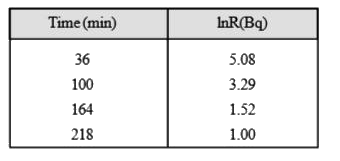At t=0, a sample of radionuclide A has the same decay rate as a sample of radionuclide B has at t=30min. The disintegration constants are and , with . Will the two samples ever have (simultaneously) the same decay rate?
Step by step video & image solution for At t=0, a sample of radionuclide A has the same decay rate as a sample of radionuclide B has at t=30min. The disintegration constants are lambda_(A) and lambda_(B), with lambda_(A)ltlambda_(B). Will the two samples ever have (simultaneously) the same decay rate? by Physics experts to help you in doubts & scoring excellent marks in Class 12 exams.
Topper's Solved these Questions
- BOOK - PHYSICS GALAXY - ASHISH ARORACHAPTER - NUCLEAR PHYSICS AND RADIOACTIVITYEXERCISE - Concptual MCQs48videos
NUCLEAR PHYSICS AND RADIOACTIVITY
- BOOK - PHYSICS GALAXY - ASHISH ARORACHAPTER - MAGNETIC EFFECTS OF CURRENT AND MAGNETISMEXERCISE - U.N.P79videos
MAGNETIC EFFECTS OF CURRENT AND MAGNETISM
- BOOK - PHYSICS GALAXY - ASHISH ARORACHAPTER - PHOTOELECTRIC EFFECT AND MATTER WAVESEXERCISE - Unsolved numerical problems42videos
PHOTOELECTRIC EFFECT AND MATTER WAVES
Similar Questions
Knowledge Check
- Question 1 - Select One
At t=0,a sample of radionuclide A has the same decay rate as a sample of radionuclide B has at t=60 min. The disintegration constants of A and B are λA and λB respectively, with λA<λB.
AThe half life of radionuclide A is greater than that of B.BAt t=60 min, number of atoms in sample of meterial A is greater than that of smaple B.CThe two samples will never have the same decay rate simultaneously.DAfter some time, the two samples will have the same decay rate simultaneously for an instant. - Question 2 - Select One
The decay constant λ of a radioactive sample:
ADecreases with increase of external pressure and temperatureBIncrease with increase of external pressure and temperatureCDecreases with increase of temperature and increase of pressureDIs independent of temperature and pressure. - Question 3 - Select One or More
Sample of two radioactive nuclides A and B are taken. λA and λB are the disintergration constants of A and B respectively. In which of the following cases, the two sample can simultaneously have the same decay rate at any time ?
AInitial rate of decay of A is twice the initial rate of decay of B and λA=λBBInitial rate of decay of A is twice the initial rate of decay of B and λA>λBCInitial rate of decay of B is twice the initial rate of decay of A and λA>λBDInitial rate of decay of B is same as the rate of decay of A at t=2h and λB=λA
Sample of two radioactive nuclides A and B are taken. λA and λB are the disintergration constants of A and B respectively. In which of the following cases, the two sample can simultaneously have the same decay rate at any time ?
View SolutionA sample of radioactive meterial has mass m, decay constant λ, and molecular weight M. Avogardo constant =NA. The initial activity of the sample is:
View SolutionA radioactive sample decays to form a stable nuclide. A graph showing variation of rate of disintegration (dNdt) of radioactive sample with time (t) is
View SolutionA radioactive nuclide can decay simultaneously by two different processes which have decay constants λ1 and λ2. The effective decay constant of the nuclides is λ.
View SolutionThe decay constants of a radioactive substance for a and b emission are λa and λb respectively. If the substance emits α and β simultaneously, the average half life of the material will be -
View Solution


